Geekom A8 Max Mini PC AMD Ryzen 9 8845HS review
Geekom A8 Max: 30-second review
One of the leading manufacturers in the Mini PC market, Geekom has impressed me with previous PCs in terms of build quality, features, and processing power. The A8 Max mini PC takes that processing power and connectivity up yet another notch, and it’s good to see that once again, we have an AMD Ryzen 9 8945HS with integrated AMD Radeon 780M graphics.
This combo is partnered with a dedicated NPU (Neural Processing Unit), which is capable of delivering a 60% improvement for applications that are compatible with the AI boost. This means that programs running in the Adobe Creative Suite see a significant boost in performance, which was highlighted in this test when editing 4K video in Premiere Pro.
This machine is extremely powerful, ploughing through tasks in Microsoft Office and applications from the Adobe Suite without too much issue. Using Photoshop and Premiere Pro, it was able to keep pace with short-form HD and 4K edits. Looking at gaming and loading Hogwarts Legacy, I started to see the AMD Radeon 780M graphics processor start to struggle.
However, this wasn’twasn’t an issue, as this machine is equipped with two USB4 ports on the back, enabling the connection to an eGPU to give the system a graphics boost. While this does the job and enables smooth and happy gameplay, you do have to contend with the fact that the CPU is handling additional processing, meaning the fans do kick in and are audible.
However, any way you look at it, this device is outstanding and one of the best mini PC units for creative studios due to the dual network connections at the back and multiple other connection options, making it extremely flexible. And while it might not replace many top gaming PCs quite yet, considering the price and what’swhat’s on offer, it’sit’s exceptionally good value.
Geekom A8 Max: Price and availability
- How much does it cost? $919
- When is it out? Now
- Where can you get it? Widely available
The Geekom A8 Max is widely available and can be purchased directly from the official Geekom US website for $1019 (click here) and the Geekom UK site for £1050 (click here).
It’s also available through online retailers such as Amazon for a similar price.
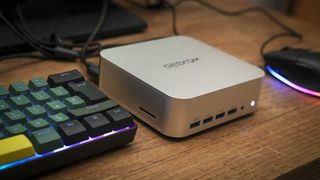
Geekom A8 Max: Specs
| Item | Spec |
|---|---|
| CPU: | AMD Ryzen 9 8945HS |
| GPU: | AMD Radeon 780M |
| RAM: | 32GB DDR5 |
| Storage: | 2TB SSD |
| Front Ports: | 4 x USB3.2 Gen2 Type-A, 3.5mm Stereo Headphone, Power Button |
| Rear Ports: | DC, 2 x USB 4.0 Type C, 2 x 2.5G RJ45, USB 3.2 Gen2 type A, USB 2.0 Type A, 2 x HDMI 2.0. |
| Connectivity: | LAN 2.5Gbps, Bluetooth 5.2, WiFi 6E |
| OS: | Windows 11 Pro (pre-installed) |
| Dimensions: | 127.6 × 127.2 × 16mm |
| Accessories | VESA Mount |
Geekom A8 Max: Design
Removing the Geekom A8 Max from the box, and the quality instantly stands out with it’s almost full metal design which is a touch larger than most of the Mini PC’s that I have looked at recently.
When it comes to the size and weight, it measures in at 135 x 132 x 45.9 mm and weighs just 685 grams, which means it will easily fit on a desktop. If needed, there’s also a VESA mount, enabling you to wall-mount the machine.
Looking at the front, there’s a selection of four USB Type-A ports, all of which are USB 3.2 Gen 2, offering up to 10 Gbps transfer speed. Next to this is a standard 3.5 mm stereo headset jack and the power button, whilst around the side, there’s an SD card reader—again, ideal for anyone working in photography, video, or the creative sector. As ever there’s also a Kensington Lock which is especially relevant if you’re using this in a works van.
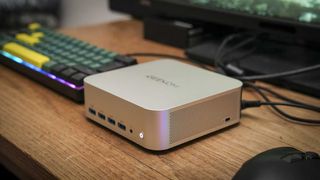
Taking a look around the back, you have the main DC input for power, and alongside this, there is a well-balanced selection of connection ports, including an HDMI 2.0 port on each side, two USB 4.0 ports, two 2.5G RJ45 network ports, one USB 3.2 Gen 2 Type-A port, and another USB 2.0 Type-A port. It’s a shame that with all these ports, there isn’t a USB 3.2 Gen 2×2 option, as most portable SSDs used by the creative sector support this standard, meaning there’s no way to access the faster 20 Gbps transfer speed on this particular mini PC. You can of course go for USB 4.0 drives but these are at present less common and far more expensive.
Inside the small frame, there’s the high-powered CPU, GPU, and NPU to consider, and when these are under load, this mini PC requires a significant cooling system to keep everything in check. As such, the Geekom A8 Max features the IceFlow 2.0 cooling system, designed by the company to manage the heat generated by the internal components.
This has been engineered to work quietly, and while it does a relatively good job, when the machine is pushed, the fans are definitely audible. Another point to highlight is the fact that while the PC is supplied with a DC power supply it will also accept USB power in through the left USB 4.0 port on the back. This makes it easier to rig into a system, but you do need to check the specifications of the power source as not all adapters will work.
As a whole, the design and build of the GEEKOM A8 Max is exceptionally good. It’s a professional-level mini PC that will suit any design studio or professional looking for a high-quality PC with high-end processing capabilities.
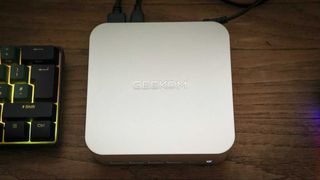
Geekom A8 Max: Features
The A8 Max is a mini PC that, while small in physical size, is big on features. First and foremost is the processing power of the Ryzen 9 8945HS processor inside, which is coupled with the AMD Radeon 780M—a popular combo. This is complemented by DDR5-5600 MT/s RAM, with the machine supporting up to 64 GB. The model I’m reviewing here comes with 32 GB of DDR5 RAM as standard.
Internal storage is facilitated by a single M.2 2280 PCIe 4.0 SSD, which is fairly standard. While there are a few different configurations of this machine available, this review unit is equipped with the 2 TB option.
On the back of the machine, there’s a host of ports, as I’ve already gone through. If you’re using this on a work network, the most notable features are the dual 2.5G Ethernet ports, Wi-Fi 6E, and Bluetooth 5.2, providing a good range of wired and wireless connection options. The machine also comes pre-installed with Windows 11 Pro.
Whilst the machine offers plenty of power, it doesn’t draw a huge amount, using a 65 W power adapter, which makes it extremely energy efficient. A nice feature is that alongside the DC power input you can also utilize USB power input through one of the USB 4.0 ports which should appeal to anyone using this in a powered rig or van.
At the heart of the machine is the Radeon 9 AI chip, this utilises 4nm processor technology and is combined with Zen 4 architecture and RDNA 3 graphics architecture, which has been finely tuned to work with the Adobe Creative Suite—again highlighting that this is a machine well suited to the creative sector.
As I’ve already seen with many other machines that utilise the 780M integrated GPU, whilst it can’t quite compete—despite all the marketing and advertising around it—with dedicated desktop graphics processors, it does an exceptional job and most games with graphics adjust should run fine if not at max framerate or quality.
One features that’s useful for office based use is the dual Ethernet ports. This essentially enables it to be used with a NAS as well as a soft router, and I found this wired connectivity was perfect for my small home studio.
When it comes to connectivity, this machine is well catered for, but it’s the USB4 ports that boost the machine enabling expansion options. For me, that means I can connect high-speed external SSDs with a 40 Gb/s transfer rate, as well as an external eGPU if I need extra graphics processing power.
Another great feature is that, with the two HDMI ports at the back and the two USB 4.0 ports, you can connect up to four 4K monitors, again reflecting its suitability for the creative sector. If you need to increase the resolution, you can also attach a single 8K monitor if required.
Internally, to keep everything cool, the system utilises IceFlow 2.0, Geekom’s own cooling system. Essentially, it uses a large fan and copper tubing to dissipate heat away from the processor, helping to prevent thermal throttling.
Finally, when it comes to software, it comes pre-installed with Windows 11 Pro, once again highlighting the fact that this is a professional-level rather than a standard consumer-level mini PC.
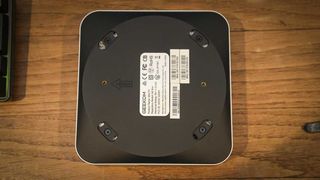
Geekom A8 Max: Performance
| Mini PC | Header Cell – Column 1 | Header Cell – Column 2 |
|---|---|---|
| 3DMark | WildLife | 17573 |
| Row 1 – Cell 0 | Fire Strike Overall | 7737 |
| Row 2 – Cell 0 | Fire Strike Graphics | 8372 |
| Row 3 – Cell 0 | Fire Strike Physics | 26667 |
| Row 4 – Cell 0 | Fire Strike Combined | 2939 |
| Row 5 – Cell 0 | Time Spy Overall | 3314 |
| Row 6 – Cell 0 | Time Spy Graphics | 2952 |
| Row 7 – Cell 0 | Time Spy CPU | 10872 |
| CineBench23 | Single | 1806 |
| Row 9 – Cell 0 | Multi | 16594 |
| GeekBench | Single | 2691 |
| Row 11 – Cell 0 | Multi | 13364 |
| Row 12 – Cell 0 | Compute | 30145 |
| CrystalDisk | Read MB/s | 5055.12MB/s |
| Row 14 – Cell 0 | Write MB/s | 4367.66MB/s |
| PCMark 10 | Office | 7174 |
| WEI | Row 16 – Cell 1 | 8.2 |
The Geekom A8 Max is aimed at the premium end of the mini PC market, and its stylish design, impressive array of ports, and features pit it against many of the other powerful mini PCs that I’ve reviewed. When it comes to performance, it closely rivals the competition and side by side; it’s similar in performance to the Geekom GT One Mega mini PC that I looked at back in October. The main difference between these two PCs is the fact that the GT One Mega features an Intel processor, whereas the A8 Max goes all out AMD.
Actually, when it comes to performance, both are pretty evenly matched, with the Mega just taking the edge in some tests, while the Max performs better in others. When it comes to price, they’re also comparable.
Getting started with performance, I ran it through all the usual checks, and sure enough, the internal SSD, despite being restricted to a single 2 TB stick, does offer impressive transfer rates, topping out at 5055 MB/s read and an equally impressive 4367 MB/s write. This shows that the A8 Max is more than suitable for most administrative tasks, as well as video editing all the way up to 8K as long as that edit isn’t too complex. The only bit that holds it back here is the capacity of 2 TB, which in most scenarios would be more than adequate, but for video editing, it is limiting. However, there is the option to plug in a larger ultrafast 40 Gbps SSD into one of the two USB4 ports at the back.
Looking at day-to-day PC performance, and its ability to handle all Microsoft Office apps, the PCMark score of 7174, alongside the Windows Experience score of 8.2, shows that for admin tasks, word processing, internet browsing, and even web streaming, this machine has more than enough power to handle pretty much anything you want to do with it.
When you take that performance up a notch and start to look at the video and photography side, using the machine for both viewing and editing, the Cinebench scores are in line with the Mega machine that I had previously looked at and had impressed with the performance in both Photoshop and Premiere Pro. Likewise, when it came to the 3D potential and gaming, the Fire Strike, Time Spy, and Wild Life scores again showed the machine putting in an excellent performance, with the 780M processor able to handle most graphics with relative ease, although notably not high end gaming.
However, a few things to note on the performance of the machine with some use: the fans kick in to keep everything cool, and there is some notable noise from the system once it is under load.
When it comes to graphics performance, playing some of the higher-end, graphics-intensive games such as Cyberpunk 2077 or Hogwarts Legacy, you can really start to see the limitations of the 780M chip. An eGPU can be connected to the USB 4.0 port to perform a little more of a boost.
Overall, when it came to the processing power of the A8 Max, I have to say that I was impressed all around with its performance—especially the way that the AMD AI-enhanced CPU was able to handle many of the AI tasks that are accessible through the Adobe Creative Suite. Again, here we see the machine handle those tasks with relative ease, with performance that is a step up from what you would expect from a non-AI-enhanced machine.
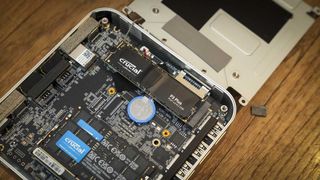
Geekom AE8: Final verdict
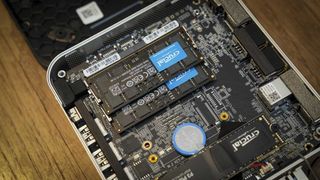
The A8 Max is a stylish machine that will suit any design studio or office where a high-performance mini PC is required over a more space-consuming desktop machine. The style itself is nice and sleek, and the compact design with the ability to be VESA mounted means that it can free up space. I also like the fact that it has a row of four USB Type-A ports across the front, although it would’ve been nice to see at least the addition of one, if not two, USB Type-C ports preferably Gen2 2×2.
In use, the machine boots up quickly, and for me, one of the big highlights of this machine, as with the GT One Mega, is the fact that it features an SD card reader built into the side. Whilst I would’ve preferred this to be mounted on the front, the fact that it’s included at all just makes things easier when downloading images or footage.
Again, coupled with a decent SSD such as the LaCie Tough 4 TB, the A8 Max put in an impressive performance when used with both Photoshop and Premiere Pro with images and footage from the Sony A7 IV.
When it comes to general day-to-day admin, the machine absolutely excels, and there is no issue at all. However, at close to $1,000/£1,000, that is quite a lot of money to spend on a machine that you’re solely going to use for Microsoft Office and browsing the internet. Where I found this machine really comes into its own is with creative applications such as Photoshop, InDesign, and Premiere Pro, at which point harnessing the AI power really does make a difference.
If you want to play a few games, then it can handle most mid to high-end titles, although you might have to pull back on the graphics slightly for some of them. If you are looking to aim higher with gaming and play the likes of Cyberpunk 2077, Hogwarts Legacy, or the new Indiana Jones game, it’s either worth investing in an eGPU to use alongside this machine or look for a dedicated gaming machine, which might be a better option.
Should I buy a Geekom A8 Max?
| Value | At the top end of the mini PC market, with great options for creatives | 4 |
| Design | Sleek and stylish outer design is matched by quality internals that pack plenty of power | 4.5 |
| Features | A powerful CPU and GPU are joined by an AI NPU for a boost in many applications’ processing power | 4.5 |
| Performance | For a machine that’s so small, it doesn’t hold back on its abilities, with only the graphics struggling with high-end gaming | 4.5 |
| Overalls | Great value for money considering its abilities, but you are paying a slight premium for the size | 4.5 |
Buy it if…
Don’t buy it if…
For more on-the-go devices, we’ve tested the best business laptops around.
#Geekom #Max #Mini #AMD #Ryzen #8845HS #review
